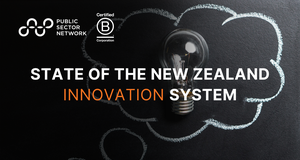
Qualtrics
and the
Public Sector Network
recently collaborated to deliver the
Hitting Digital Transformation Targets across the Public Sector
Virtual Event
on 26th of May 2022.
After the event, we were grateful to have had the opportunity to interview
Phillip Bland, Principal Industry Advisor Public Sector Solution Strategy ANZ from Qualtrics
in an intimate conversation on his perspectives with technology trends and barriers faced in their community.
What overall trends are you seeing in terms of technology in your industry?
Government is in an interesting position when it comes to technology trends. The pandemic has accelerated the shift to digital interaction. 59% of citizens we surveyed recently told us they increased their use of government digital platforms since the start of 2020. App dedicated and mobile responsive applications are becoming expected by citizens, which in turn means the same functions and features are being compared to leading digital applications such as Uber.
We are seeing approaches of user centered design and development become common practice, there is now much more focus on capturing the voice of citizen to make design and process decisions when it comes to technology implementation and development which also means more investment into technologies that an analyse and make sense of unstructured data.
Given government employees are citizens (and citizen/consumer expectations have flow on effects in terms of employee expectations), it is also important to consider the employee technology experience. We know from recent Qualtrics research that only 30% of employees across Australia & New Zealand report that their organisation’s technology currently meets their expectations - this highlights a large experience gap to close! Our research also shows that investing in improvements will pay off in many ways - beyond supporting flexible work and driving retention, Qualtrics research suggests that when organisations invest in understanding and improving employee technology experiences, employees are 3x more likely to be engaged and productive at work, and more likely to report high levels of wellbeing.
There is an emergence of government focus on empathy at scale. Empathy at scale is not a hyper personalised chatbot, it is the ability to analyse large amounts of unstructured experience data in open text, social comments and employee recommendations to understand situations, emotions, expectations, behaviours and outcomes at scale in easily accessible dashboard views tailored to diverse roles and decisions makers.
What is the next big thing in terms of technology and where do you see it in the next 2 to 5 years?
Although government may not always lead trends there are already agencies looking closely at digital identity frameworks. Digital Identity will be a significant trend in the public sector space. Enabling digital identity will bring commercial, regulated and government industries together to verify a person's identity to conduct numerous jobs to be done. Digital identity has an ability to overcome data sharing barriers across regions and jurisdictions by creating interoperability and government thinking like an enterprise rather than a set of services and agencies. This will lead to lower effort and more seamless experiences for citizens.
In recent times there has been a focus on technology being an automation option such as chatbots replacing phone calls and digital transactions replacing in person applications. We are already seeing a new focus on technology augmenting experiences rather than replacing them. This is seen with always on listening tools for live real time feedback analysis and workflows to recover poor interactions. The data generated by always on listening tools is being used to provide real time coaching insights to employees to create better outcomes. Investing in technology that can automate simple tasks reduces cost to serve and allows for a repurposing of the workforce to spend more time with citizens on complex needs than trying to complete transitions quickly.
In relation to government employee technology experiences, we also know that flexible work is here to stay and will be critical in terms of the government competing with the private sector for hard to find talent now and into the future. In Qualtrics recent research into employee experience trends, we found that the volume of respondents saying they would be more likely to search for a new job if required to return to the office full-time is higher in Australia and New Zealand compared to the global average (43 per cent vs 35 per cent). As such, it will be critical for government to invest in new technologies to better support flexible work and to leverage employee feedback to make data-driven decisions about what technology investments to prioritise.
Aside from the pandemic , what have been some of the technology challenges or barriers experienced in the last 12 months?
Beyond the pandemic the challenges in the public sector are not the technology capabilities but rather the ability for government policy to keep up with new capabilities, and then go beyond with hiring and training to leverage emerging technology. Earning citizen trust in the digital channel will also remain a priority and it's more than just a polished digital experience. The way that technology handles consent and privacy in relation to citizen information will remain critical. We live in a world where there is an increased focus on cybersecurity and the impacts this can have when records are breached.
Technology that enables citizens to have control over where and with whom they share information will be a key priority. Omni channel secure workflows across multiple agencies are becoming more common as digital transactions replace simple interactions, more complex needs emerge in voice and in person channels. Augmenting technology that can solve the problem of moving citizen needs across multiple agencies will become further in demand.
From an employee perspective in government, we are also seeing several agencies having challenges with driving digital transformation because they are not effectively tuning into the employee voice throughout the transformation process. Implementations of new systems & technologies often run over time & budget and do not delivering the expected value because of employee resistance. Finding more effective ways to listen, understand and act on employee feedback throughout all stages of the implementation process can help mitigate risk, maximise buy-in & adoption of new tools & technologies; and support continuous improvement post go-live.
What has been your best performing technology in the last 12 months and why?
At Qualtrics we are seeing governments creating strong outcomes in both Employee and Customer Experience with always on feedback technologies & solutions. In Customer channels providing un-intrusive predictive feedback paths that measure beyond a simple good or bad question at the end of a transaction. Allowing citizens at any point in a journey to share feedback on the quality of information provided, clarity on follow up actions and even intent to use a service again are ways agencies are operating with leading insights rather than lagging customer outcomes.
For an employee perspective, an example of an always on listening solution may involve using QR codes around the office or on the intranet to enable employees to report issues such as bullying and harassment, or share suggestions for improvement and innovative ideas, in real-time.
Agencies are supplementing traditional CX insights with operational data to understand the link between a CSAT score and operational performance such as interaction time. They are structuring questions on effort with open text which can be analysed using machine learning to pick up emerging topics and themes. They are also actively demonstrating feedback doesn’t happen in an isolated bubble and if a citizen tells them the experience is poor, they can alert key stakeholders to respond swiftly through workflows integrated into existing systems (such as Microsoft teams or Service Now).
Another key focus area and innovation is learning from the channels that are not owned by government agencies. Ethical social listening to understand what communities are talking about and what is important to them is becoming more prioritised.





















